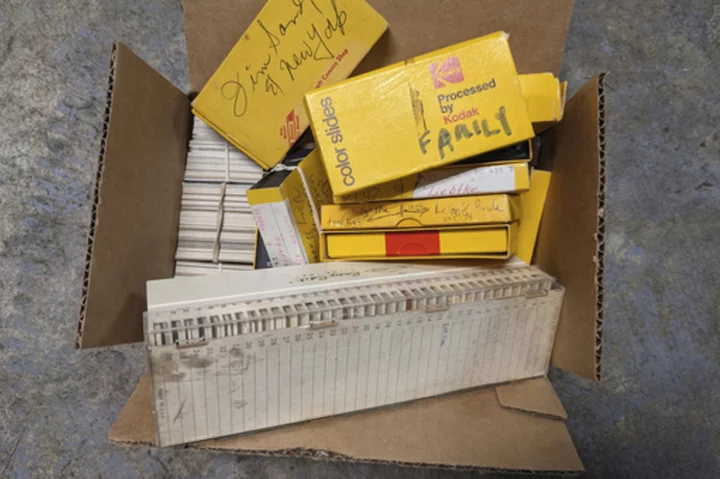DETROIT (AP) — Davion Williams wants to go to college. A counselor at his Detroit charter school last year helped him visualize that goal, but he knows he’ll need more help to navigate the application process.
So he was discouraged to learn the high school where he just began his sophomore year had laid off its college transition adviser – a staff member who provided extra help coordinating financial aid applications, transcript requests, campus visits and more.
The advisers had been hired at 19 schools with federal pandemic relief money. In June, when Detroit’s budget was finalized, their jobs were among nearly 300 that were eliminated.
“Not being able to do it at this school is kind of disappointing,” Williams said in August at a back-to-school event at Mumford High School.
An unprecedented infusion of aid money the U.S. government provided to schools during the pandemic has begun to dwindle. Like Williams' school, some districts already are winding down programming like expanded summer school and after-school tutoring. Some teachers and support staff brought on to help kids through the crisis are being let go.
The relief money, totaling roughly $190 billion, was meant to help schools address needs arising from COVID-19, including making up for learning loss during the pandemic. But the latest national data shows large swaths of American students remain behind academically compared with where they would have been if not for the pandemic.
Montgomery County schools, the largest district in Maryland, is reducing or eliminating tutoring, summer school, and other programs that were covered by federal pandemic aid. Facing a budget gap, the district opted for those cuts instead of increasing class sizes, said Robert Reilly, associate superintendent of finance. The district will focus instead on providing math and reading support in the classroom, he said.
But among parents, there’s a sense that there remains “a lot of work to be done” to help students catch up, said Laura Mitchell, a vice president of a districtwide parent-teacher council.
Mitchell, whose granddaughter attends high school in the district, said tutoring has been a blessing for struggling students. The district’s cuts will scale back tutoring by more than half this year.
“If we take that away, who’s going to help those who are falling behind?” she said.
Districts have through September 2024 to earmark the last of the money provided by Congress in three COVID relief packages. Some schools have already started pulling back programming to soften the blow, and the next budget year is likely to be even more painful, with the arrival of what some describe as a “funding cliff.”
In a June survey of hundreds of school system leaders by AASA, The School Superintendents Association, half said they would need to decrease staffing of specialists, such as tutors and reading coaches, for the new school year. Half also said they were cutting summer-learning programs.
As the spending deadline looms, the scope of the cuts is not yet clear. The impact in each district will depend on how school officials have planned for the aid’s end and how much money they receive from other sources.
State funding for education across the country has been generous of late. But states may soon face their own budget challenges: They also received temporary federal aid that is running out.
Many school officials are bracing for the budget hit to come. In Shreveport, Louisiana, officials say next year they might have to cut some of the 50 math teachers they added to double up on math instruction for middle schoolers.
Schools there added the teachers after identifying deep learning gaps in middle school math, and there’s evidence it helped, with a 4-point increase in math scores, officials say. But at a cost of $4 million, the program will be in jeopardy.
“Our money practically is gone,” Superintendent T. Lamar Goree said.
Some researchers have questioned whether the money was sufficient or sustained enough to address the deep declines in learning. But with a recent deal limiting federal spending increases in education, more money from Congress will not be forthcoming.
Meanwhile, some lawmakers and commentators have pointed to anemic academic recovery to suggest schools didn't spend the COVID relief money wisely in the first place.
Experts district officials had wide discretion over how to spend the money, and their decisions have varied widely, from HVAC upgrades to professional development. “Some of the spending was very wise, and some of it looks, in hindsight, to have been somewhat foolish,” said Lori Taylor, an education finance researcher at Texas A&M University.
To date, there is limited research on whether the federal money has helped address learning loss. One recent study of eight districts’ summer school programs found no impact on reading scores but improvements in math. Since only a fraction of students in each district attended, this made only a small contribution to learning recovery, though.
School officials insist the money has made a difference.
“I wonder what the counterfactual would have been if we didn’t have the money,” said Adriana Publico, the project manager for COVID relief funds at Washoe County School District in Reno, Nevada. “Would students have been even worse off? I think so.“
The Washoe system has cut hours for after-school tutoring in half this year and eliminated teacher coaches from many elementary schools. The district just finished a dramatically expanded summer school program, but officials aren’t sure if they’ll be able to afford to continue it next summer.
Some school systems are trying to maintain COVID-era additions. In Kansas City, Missouri, district officials say they’re planning to keep a number of the positions that were added with federal money, including intervention teachers and clinicians who work with students who have experienced trauma. The district will be able to do so, said CFO Erin Thompson, because of higher property tax revenue.
“This might not be as bad as what we thought,” she said. “We’re optimistic at this point.”
In Detroit, which received a windfall of federal COVID money, district officials say they budgeted carefully to avoid steep cuts when the money runs out. This included earmarking more than half of their federal relief — some $700 million — for one-time building renovations to aging campuses across the city.
But ultimately, officials said some reductions were necessary. Expanded summer and after-school programs have been phased out, in addition to the hundreds of staff positions, like the college advisers.
“In an ideal world, I would rather have college transition advisers,” said Superintendent Nikolai Vitti. “But it’s another example of making hard decisions.”
___
Barnum reported from New York and Binkley reported from Washington, D.C.
___
The Associated Press education team receives support from the Carnegie Corporation of New York. The AP is solely responsible for all content.









